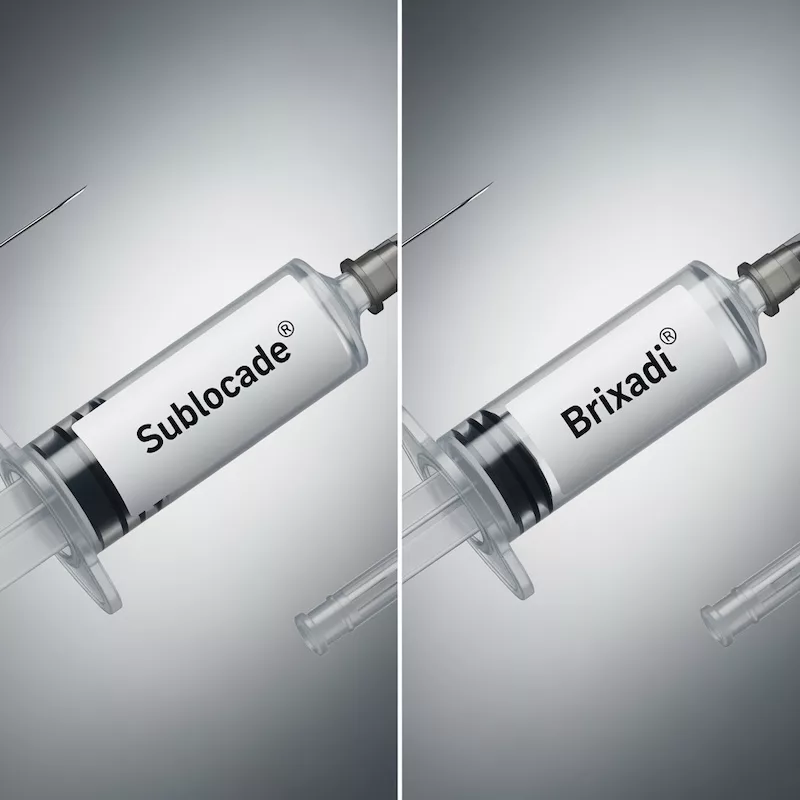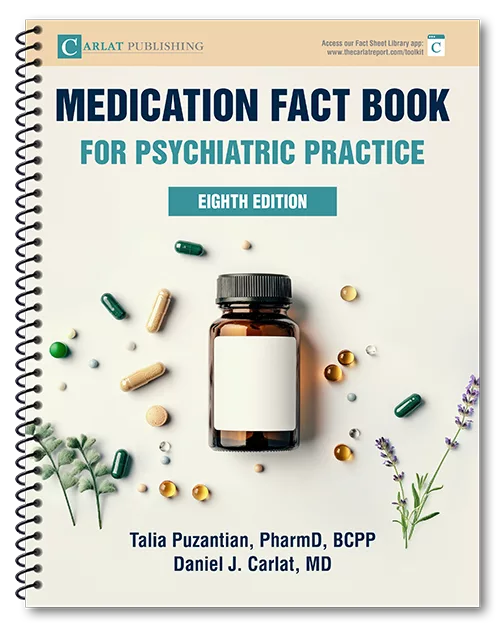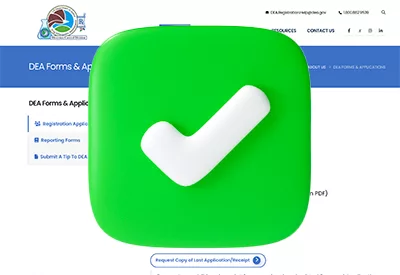There are two variations of long-acting injectable buprenorphine on the market. But what differentiates them, who might benefit, and how well do they work? Find out in today’s podcast.
Publication Date: 09/29/2025
Duration: 11 minutes, 35 seconds
Transcript:
NOAH CAPURSO: Buprenorphine is a first-line treatment for opioid use disorder, and one of the most promising new ways to deliver it is via a long-acting injection. There are two variations of long-acting injectable buprenorphine on the market. But what differentiates them, who might benefit, and how well do they work? Find out in today’s podcast.
Welcome to The Carlat Psychiatry Podcast. This is your host, Dr. Noah Capurso, the Editor-in-Chief of The Carlat Addiction Treatment Report, an associate clinical Professor of Psychiatry at the Yale University School of Medicine, and assistant medical director of addiction services at Connecticut Valley Hospital.
GENEVA VALESKA: And I’m Geneva Valeska, a graduate with a degree in Neuroscience and Cognitive Science, and a podcast coordinator here at The Carlat Report.
Long-acting buprenorphine has really changed the game for opioid use disorder, opening the options available for patients and prescribers when it comes to this lifesaving medication. Today, we’ll review when to consider long-acting injectable buprenorphine with a focus on the two currently available formulations: Sublocade and Brixadi. Both have a lot to offer, but there are some key differences that clinicians need to consider when choosing the best option for their patients.
NOAH CAPURSO: Right. Let’s start with a little background. Buprenorphine is a partial μ-opioid receptor agonist and one of the most effective medications for treating opioid use disorder. It’s been around for decades in sublingual forms like Suboxone, which is combined with naloxone in efforts to deter misuse, and formulations without the naloxone component, formerly known as Subutex. And while sublingual buprenorphine can be effective for many of our patients, adherence can be a challenge, with mortality rates spiking six-fold in the first month after discontinuation. That’s where long-acting formulations like Sublocade and Brixadi come in. They help patients stay on their medication by removing the need to take a pill every day, eliminating the risk of running out of medication early, and cut down on the potential for misuse and diversion.
GENEVA VALESKA: Exactly. Sublocade was the first long-acting buprenorphine injection to hit the market, receiving FDA approval in 2017. It’s a once-monthly subcutaneous injection that forms a solid depot under the skin, slowly releasing buprenorphine over time. It comes in two different doses: 100mg and 300mg. Typically, patients will start with an initial 300mg dose. From there, they may keep receiving 300mg injections or drop down to 100mg. One of its biggest advantages is its very long half-life. Most patients receive Sublocade once a month, but some can space it out to every two months.
NOAH CAPURSO: And that’s a big deal, especially for patients with unstable living situations or those who have a hard time sticking to a rigid treatment schedule. The long half-life also provides a significant buffer if a patient misses an appointment. The medication lasts so long that they won’t go into sudden withdrawal if they get the medication a day or two late.
But like all medications, it’s not without its challenges. Sublocade can be a bit uncomfortable for patients to receive, as the medication itself is quite viscous. The needle is of a thick gauge, and the injection itself can be painful. Also, Sublocade creates a palpable lump under the skin that can last up to a few months, which can be a turn-off for some patients.
GENEVA VALESKA: Yes, and it comes with some administrative hurdles as well. The medication requires refrigeration before use. Additionally, clinics and pharmacies that administer Sublocade must be registered with a Risk Evaluation and Mitigation Strategy (REMS) program, though individual prescribers do not need to register. Still, this can be a barrier to access in some regions.
NOAH CAPURSO: That’s a good point. But despite these limitations, the benefits of Sublocade can be substantial. Studies have shown that patients who switch to Sublocade tend to have high treatment retention and satisfaction rates, with reduced opioid cravings and a lower risk of relapse. It’s been shown to be particularly useful for patients transitioning out of controlled environments, like incarceration or inpatient settings.
GENEVA VALESKA: One more thing to add about Sublocade. Recent formulations adjustments now allow the medication to last outside the refrigerator at room temperature for up to 12 weeks. The manufacturer also recently changed guidance so that Sublocade no longer has be given in just the abdomen, allowing administration also in the thigh, buttock, and back of the upper, just like Brixadi.
And that brings us to our newcomer – Brixadi. This medication has a lot in common with Sublocade, but there are some unique features that set it apart. The big distinction is the range of doses options, that come in both weekly and monthly formulations. The manufacturer’s website has a nice table that shows all seven dosing options and their equivalence to sublingual buprenorphine. So there’s a lot more flexibility with Brixadi, which is appealing, though whether or not this actually translates into improved patient outcomes remains to be seen.
NOAH CAPURSO: I’ve been asked on several occasions, “Why would you want a long-acting injectable that only lasts for a week? Isn’t it true that longer is better?” My answer is: Well, not necessarily. At least theoretically, weekly formulations are suited for patients, typically early in recovery, who have adherence or diversion concerns, but may also benefit from more frequent check-ins for additional support. On the other hand, monthly injections can be used for patients who either do not need the same high level of support, or even for those who might simply have difficulty making into the clinic.
GENEVA VALESKA: Exactly. Brixadi has a few practical advantages as well. First, it uses a smaller 23-gauge needle, which reduces injection side pain (Blue TR et al, J Addict Med 2025; Epub ahead of print), which, as we know, can be a major deterrent for some patients. Plus, it doesn’t require refrigeration, which makes it a bit easier to store and transport.
So, how do we know which formulation will work best for our patient? Well, one possible answer comes from how the medication is started. In general, it is recommended that, whenever possible, patients be stabilized on sublingual buprenorphine for at least a few days before transitioning to a long acting formulation. That gives providers a chance to determine optimal dosing and tolerability. But there is an intriguing recent study by D’Onofrio and colleagues published in 2024 in the journal JAMA Network Open, that showed that Brixadi may be used very early in opioid withdrawal.
NOAH CAPURSO: That’s right. We’ve all heard of buprenorphine precipitated opioid withdrawal, which occurs if buprenorphine is given too early and patients still have opioids in their system. But in this study, researchers showed a 24mg dose of weekly Brixadi could be safely administered to people in an emergency room before they went into withdrawal. They took advantage of the fact that it takes Brixadi a day to reach peak serum concentration. That means that the medication took effect slowly enough to avoid withdrawal, gradually replacing the opioid agonist as it worked its way out of a patient’s system. The whole induction process in this study was just a single injection, and since the medication was long acting, that single dose covered them for a week.
GENEVA VALESKA: It’s an interesting result, but we should caution that this use of Brixadi has not been thoroughly studied. We need more research before recommending this as standard practice, though it could may be an approach to consider in the emergency room.
NOAH CAPURSO: So what’s the bottom line? Well, Long-acting injectable formulations of buprenorphine can be helpful for patients with adherence challenges, diversion concerns, transportation difficulties, or for those people who simply don’t want to take a pill every day.
Of the two available formulations, Sublocade has the longer half-life, so this is the one we would recommend for patients who have a history of poor adherence or not making it into clinic regularly.
GENEVA VALESKA: The other formulation, Brixadi, does not last quite as long, but it has more available doses, including weekly and monthly options. Brixadi administration is also less painful than Sublocade, and in fact, a recent small study showed that of patients who had received both, more preferred Brixadi than Sublocade (Blue et al, 2025).
Finally, new research shows that Brixadi may be useful in the induction process, allowing patients in acute care settings to directly transition onto long-acting buprenorphine without needing to be in opioid withdrawal (D’Onofrio G et al, JAMA Netw Open 2024;7(7):e2420702). This practice hasn’t been studied widely, but it is intriguing, and we’ll be keeping an eye out to see where it goes.
NOAH CAPURSO: Ultimately, the choice between Sublocade and Brixadi will depend on the individual patient’s needs, their stability in recovery, and logistical factors like access to care and insurance coverage. For patients who benefit from frequent monitoring, Brixadi’s weekly option might be ideal, while those who fewer clinic visits might do better on Sublocade’s longer-acting formulation.
GENEVA VALESKA: That’s a great point. Thanks for joining us today. If you found this discussion helpful, don’t forget to subscribe to the podcast for more conversations about addiction treatment and psychiatry.
NOAH CAPURSO: And as always, thanks for listening. We’ll catch you next time.


_-The-Breakthrough-Antipsychotic-That-Could-Change-Everything.webp?t=1729528747)



